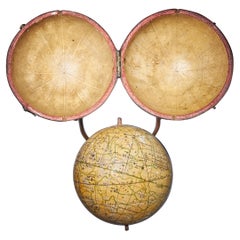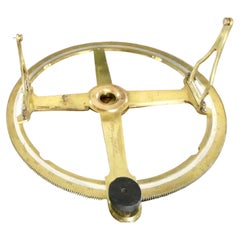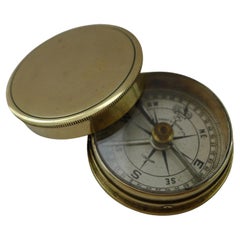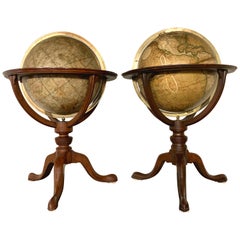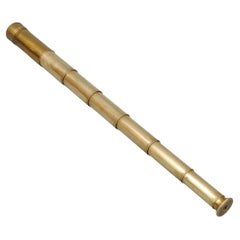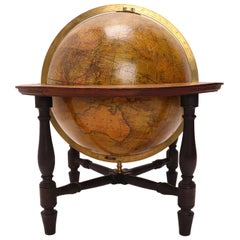Cary, London Scientific Instruments
to
2
2
1
1
1
1
1
1
2
2
2
2
2
2
1
8
6
5
4
Creator: Cary, London
Rare George III Celestial Pocket Globe by Cary, London
By Cary
Located in Oxfordshire, United Kingdom
A fine and rare 3" celestial pocket globe by G & W Cary, Strand, London circa 1791, housed in its original sharkskin case.
A companion globe to terrestrial globes of this type we...
Category
Late 18th Century English George III Antique Cary, London Scientific Instruments
Materials
Plaster
Fine Circular Protractor by William Cary, London c.1810
By Cary
Located in Norwich, GB
William Cary, London Circular Protractor. C.1810
The protractor with geared knob turn for full diameter bar, double hinged scribe arms with shaped frame. Main wheel with four spokes and glass sight cross centre, full circumference inscribed divider to 360 degrees signed Cary, London to the bar. Adjustment screws to the arms and housed in it’s original mahogany case with hinged lid.
William Cary is listed as working in Strand, London from 1801 to 1825.
William Cary was an important scientific instrument maker, he trained under Jesse Ramsden (1735-1800) he produced numerous scientific instruments including mechanical calculators...
Category
1810s English Antique Cary, London Scientific Instruments
Materials
Brass
Related Items
Fine Brass Cased Pocket Compass by Short & Mason Ltd., London c.1910
By Short & Mason
Located in Bath, GB
A very fine English brass cased compass, professionally cleaned and polished restoring it to it's former glory. The face signed Short & Mason / London together with the brand name "...
Category
1910s British Edwardian Vintage Cary, London Scientific Instruments
Materials
Brass
Pair of 19th Century English J & W Cary Celestial/Terrestrial Table Model Globes
By John & William Cary
Located in Milford, NH
A fine assembled pair of 12-inch English table model globes on stands manufactured by J & W. Cary, the left globe with cartouche labeled “The New Celestial Globe, on which are correc...
Category
Early 19th Century English Antique Cary, London Scientific Instruments
Materials
Brass
$18,900 / set
H 25 in Dm 16.5 in
Antique Book, Thoughts on Hunting by William Beckford, English, Georgian, 1810
Located in Hele, Devon, GB
This is an antique book, Thoughts on Hunting by William Beckford. An English language hard bound compendium of sporting letters, dating to the Georgian period, published 1810.
An En...
Category
Early 19th Century European Georgian Antique Cary, London Scientific Instruments
Materials
Paper
$1,016
H 9.45 in W 5.91 in D 1.19 in
RARE ANTiQUE GEORGE III SHAGREEN GLASSES SPECTACLES CASE AND FOLDING GLASSES
Located in West Sussex, Pulborough
Royal House Antiques
Royal House Antiques is delighted to offer for sale this absolutely stunning George III Shargeen & Silver Spectacles case with folding glasses...
Category
18th Century European George III Antique Cary, London Scientific Instruments
Materials
Glass
$885
H 5.12 in W 2.17 in D 0.79 in
Fine Antique William IV circa 1830 Hardwood Piano Stool with Decorative Base
Located in West Sussex, Pulborough
We are delighted to offer for sale this stunning hand carved William IV circa 1830 Hardwood Piano stool
A very good looking and well-made piano stool, its exactly what collectors ar...
Category
1830s English William IV Antique Cary, London Scientific Instruments
Materials
Upholstery, Hardwood
$1,530 Sale Price
25% Off
H 19.3 in Dm 12.41 in
Zodiac Circular Backgammon Set by Alexandra Llewellyn
By Alexandra Llewellyn
Located in London, GB
An extraordinary Alexandra Llewellyn design in wood marquetry that offers an exciting new way to play this timeless game, our circular Zodiac board...
Category
21st Century and Contemporary British Other Cary, London Scientific Instruments
Materials
Carnelian, Silver
George III Banjo Mahogany Barometer by R. Taylor, Chepstow, England c. 1820
By R. Taylow
Located in Atlanta, GA
A Four-dial Barometer/Thermometer in Mahogany, dating from the George III period, and English in origin. Signed at the base "R. Taylor Chepstow". The barometer with swan neck pedim...
Category
Early 19th Century English George III Antique Cary, London Scientific Instruments
Materials
Brass
$3,175
H 42.5 in W 12 in D 2 in
Fine Pair of Floor Globes by J & G Cary, Dated 1820 and 1833
By George & John Cary
Located in Lymington, Hampshire
A fine pair of 15 inch floor globes by J & G Cary, dated 1820 and 1833, each set into a mahogany stand with a vase shaped support and three legs centred on a compass, one with a labe...
Category
Early 19th Century English Regency Antique Cary, London Scientific Instruments
Materials
Mahogany
Antique George III Quality Mahogany Banjo Barometer
Located in Suffolk, GB
Antique George III quality mahogany banjo barometer having a quality mahogany shaped case with a swan neck pediment and satinwood stringing, circular silvered engraved dial with orig...
Category
Early 1800s English George III Antique Cary, London Scientific Instruments
Materials
Mahogany
English Pocket Globe, London, Circa 1775-1798
By Herman Moll
Located in Milano, IT
Pocket globe
London, between 1775 and 1798
Re-edition of the globe of Hermann Moll (1678-1732) dated 1719
The globe is contained in its original case, which itself is covered in shark skin.
There are slight gaps in the original paint on the sphere. The case no longer closes.
The sphere measures 2.7 in (7 cm) in diameter whereas the case measures 2.9 in (7.4 cm) in diameter.
lb 0.22 (kg 0.1)
The globe is made up of twelve printed paper gores aligned and glued to the sphere.
In the North Pacific Ocean there is a cartouche with the inscription:
A Correct
Globe
with the new
Discoveries.
The celestial globe is depicted on the inside of the box and is divided into two hemispheres with the cartouche:
A correct globe
with ye new cons
relations of Dr.
Halley & c.
It shows the ecliptic divided into the days of the zodiacal calendar and the constellations represented as animals and mythological figures.
On the globe are delineated the equinoctial line, divided by degrees and hours, the ecliptic and the meridian (passing west of Greenwich). The continents are shaded and outlined in pink, green and yellow. It shows: the Cook routes; a wind rose in the Southern Indian Ocean; Antarctica without land; Africa with Negroland (Hermann Moll is considered the first geographer to name the West African region in his 1727 map. (Encyclopaedia Britannica, ed. 1902, under "States of Central Africa"); Tartary in Central Asia; the Mogul kingdom in northern India; in North America only New England, Virginia, Carolina, Florida, Mississippi are identified; California is already a peninsula; the northwest coast of America is "unknown parts" (Alaska is not described and it is only partially delineated, it was to become part of the United States in 1867); Mexico is named "Spain"; Central South America "Amazone America". Australia (which was to be so named after 1829) is called New Holland. The route of Admiral Anson is traced (1740) and the trade winds are indicated by arrows. (See Van der Krogt, P., Old Globes in the Netherlands, Utrecht 1984, p. 146 and Van der Krogt, P. - Dekker, E., Globes from the Western World, London 1993, pp. 115.)
Elly Dekker, comparing Moll’s 1719 globe and his re-edition (of which the one described above is a sample), identifies the differences between them: the two editions are quite similar to each other, but in the "anonymous" globe, compared to the previous globe of 1719, California looks like a proper peninsula - the reports of the Spanish explorers of the region had given rise to uncertainty over whether it was connected to the mainland or not. The geographical nature of California was confirmed after the explorations of Juan Bautista de Anza (1774-1776). The routes of Dampier's journey were partially erased and the route of Captain James Cook's first voyage was superimposed on them, and the geography of Australasia was adapted accordingly, including the denomination of the Cook Strait. See Dekker, Elly, Globes at Greenwich, 1999.
An important ante quem element is represented by Tasmania: it is not separated from Australia by the Bass Strait...
Category
Late 18th Century English George III Antique Cary, London Scientific Instruments
Materials
Shagreen, Paper
George III Rare Bronze Cased Chronology of the Sovereigns of England
Located in Bishop's Stortford, Hertfordshire
A rare and very interesting antique Georgian bronze medallion cased set of printed discs titled CHRONOLOGY OF THE SOVEREIGNS OF ENGLAND and believed to have been produced around 1815...
Category
1810s English George III Antique Cary, London Scientific Instruments
Materials
Bronze
Pair of English 12-inch Globes by William Harris, London, 1832 and 1835
By William Harris
Located in Milano, IT
Pair of 12-inch table globes
William Harris
London, 1832 and 1835
Slight abrasions from use; few cracks
lb 11 each (kg 5)
The two terrestrial and celestial globes rest in their original Dutch style stands with four supporting turned wood columns.
Each one measures 12 in in height x 16.5 in in diameter with the diameter of the spheres measuring approximately 12 in; 48 cm in height x 42 cm in diameter x 31 cm diameter of the spheres.
The 12 inch measure was the most frequently used by British manufacturers of globes of this period.
Each globe is composed of two series of twelve printed paper gores, aligned and glued onto plaster spheres.
The brass circle of the meridian bears engravings...
Category
1830s English William IV Antique Cary, London Scientific Instruments
Materials
Paper, Wood
$21,266 / set
H 18.9 in Dm 16.54 in
Previously Available Items
Early 19th Century Small Six Draw Pocket Telescope by Cary
By Cary
Located in Lincolnshire, GB
An early 19th century lacquered brass six drawer pocket telescope by Cary, London. Unusual focusing line on the second drawer, the scope complete with end cap.
Category
Early 19th Century English Antique Cary, London Scientific Instruments
Materials
Brass
Terrestrial Globe Signed Cary, London, 1800
By Cary
Located in Milan, IT
Large 'Papier Machè' terrestrial globe ( 12” diameter ), with gores printed in calcography and color finished, on a wooden base. Maker CARY. London, England, circa 1800.
Category
Early 1800s British Antique Cary, London Scientific Instruments
Materials
Brass
Terrestrial Globe Signed Cary, London, 1798
By Cary
Located in Milan, IT
Large 'Papier Machè' terrestrial globe (12" diameter), with gores printed in calcography a color finished, on a wooden tripod. One compass joints the three feet. Brass meridian. Make...
Category
1790s British Antique Cary, London Scientific Instruments
Materials
Brass
WWI 1915 British Army Officer's Compass, Verner's Patent MK VII by Cary, London
By Cary
Located in Bath, GB
This is an excellent original example of the MK VII. It is fully functioning, has a brass case and is mounted with lanyard ring. The glass face and numbered brass outer ring are perf...
Category
1910s English George IV Vintage Cary, London Scientific Instruments
Materials
Brass
H 4 in W 3 in D 1.75 in
Cary, London scientific instruments for sale on 1stDibs.
Cary, London scientific instruments are available for sale on 1stDibs. These distinctive items are frequently made of metal and are designed with extraordinary care. There are many options to choose from in our collection of Cary, London scientific instruments, although beige editions of this piece are particularly popular. Many of the original scientific instruments by Cary, London were created in the Georgian style in united kingdom during the 19th century. Prices for Cary, London scientific instruments can differ depending upon size, time period and other attributes — on 1stDibs, these items begin at $3,283 and can go as high as $12,884, while a piece like these, on average, fetch $8,344.
